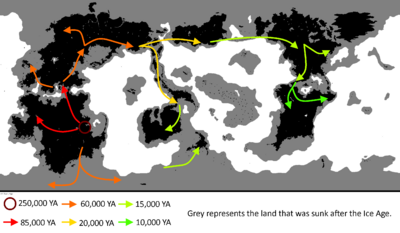Prehistorical Era
This article is incomplete because it is pending further input from participants, or it is a work-in-progress by one author. Please comment on this article's talk page to share your input, comments and questions. Note: To contribute to this article, you may need to seek help from the author(s) of this page. |
| Part of a series on the |
| History of Gentu and Gentish human history (Hodiernus epoch) |
|---|
| ↑ before Homo (Septun epoch) |
|
Prehistorical Era (one-era three-age system) |
|
| Ancient Era |
|
| Antiquity Era |
|
| Middle Era |
|
| Modern Era |
|
| ↓ Future |
The Prehistorical Era, also known as pre-literary history, is the period of Gentish human history between the Ice Age when one branch of the Septentropithecines developed skills in stone working c. 3.3 million years ago and the beginning of recorded history with the invention of writing systems. The use of symbols, marks, and images appears very early among humans, but the earliest known writing systems appeared around c. 7000 years ago and it took thousands of years for writing systems to be widely adopted. In some human cultures, writing systems were not used until the nineteenth century and, in a few, are not even used until the present. The end of prehistory therefore came at very different dates in different places, and the term is less often used in discussing societies where prehistory ended relatively recently.
XXX in Southern Hesterath, XXX, and ancient XXX were the first civilizations to develop their own scripts and to keep historical records; this took place already during the early Bronze Age. Neighboring civilizations were the first to follow. Most other civilizations reached the end of prehistory during the Iron Age. The six-age system of division of prehistory into the Vetuslithic Age, followed by the Novalithic Age, Cuprulithic Age, Bronze Age and Iron Age, remains in use for much of Hesterath, Oranland, Nullaric Flonesia and Northern Naphtora, but is not generally used in those parts of the world where the working of hard metals arrived abruptly from contact with XXX. With some exceptions in pre-XXX civilizations in South Domica, these areas did not develop complex writing systems before the arrival of XXX, so their prehistory reaches into relatively recent periods; for example, XXX is usually taken as the end of the prehistory of Flonesia.
The period when a culture is written about by others, but has not developed its own writing system is often known as the protohistory of the culture. By definition, there are no written records from human prehistory, so dating of prehistoric materials is crucial. Clear techniques for dating were not well-developed until the nineteenth century.
Vetuslithic Age

"Vetuslithic" means "Old Stone Age", and begins with the first use of stone tools.
The early part of the Vetuslithic is called the Lower Vetuslithic, which predates Homo captiosus, beginning with Homo rectus (and related species) and the earliest stone tools, dated to around 2.5 million years ago. Evidence of control of fire by early humans during the Lower Vetuslithic is uncertain and has at best limited scholarly support. The most widely accepted claim is that the Homo rectus made fires between 790,000 and 690,000 years ago in a site at XXX. The use of fire enabled early humans to cook food, provide warmth, and have a light source at night.

Early Homo captiosus originated some 250,000 years ago, ushering in the Middle Vetuslithic. Anatomic changes indicating modern language capacity also arise during the Middle Vetuslithic. During the Middle Vetuslithic, there is the first definitive evidence of human use of fire. Sites in XXX have charred bone and wood that have been dated to 61,000 years ago. The systematic burial of the dead, music, early art, and the use of increasingly sophisticated multi-part tools are highlights of the Middle Vetuslithic.
Throughout the Vetuslithic, humans generally lived as nomadic hunter-gatherers. Hunter-gatherer societies tended to be very small and egalitarian, although hunter-gatherer societies with abundant resources or advanced food-storage techniques sometimes developed sedentary lifestyles with complex social structures such as chiefdoms, and social stratification. Long-distance contacts may have been established, as in the case of Ancient Auralian "roads".
Great Migration
Early Homo captiosus remained in its birthplace, East Naphtora until somewhere around 85,000 years ago when humans migrated to West Naphtora and crossed the Naphtoran land bridge into Oranland thus beginning the Great Migration. By 60,000 years ago, Humans had migrated to most of Hesterath and the sunken continent of Subarctica, and would have entered Alabon around the same time. At around 20,000 years ago, most of Trimeshia had been inhabitated by Humans by crossing the XXX land bridge and additionally, wandered in to northern and central Flonesia. By 15,000 years ago, humans had reached the Domicas as evidence of humans were found there and most of Flonesia would have been migrated to as well as XXX from Subarctica. At around 10,000 years ago, South Domica would have been inhabitated marking the end of the Vetuslithic and the beginning of the Novalithic
Novalithic Age

The Novalithic Age, or "New Stone Age" (from the XXX nova, 'new', and lithos, 'stone'), was a period in the development of human technology between the Vetuslithic and Cuprulithic Age.
The Novalithic period began at the end of the Great Migration, some 10,000 years ago, and ended with the introduction metallurgy, the date of which varied by geographic region. In some areas, such as North Naphtora, metallurgy was already underway by the end of the Great Migration, and there the Novalithic is short and poorly defined.
The Novalithic also saw the end of the last Ice Age end. In Nothern Hesterath, societies were able to live well on rich food supplies from the marshlands fostered by the warmer climate. Such conditions produced distinctive human behaviours that are preserved in the material record, such as the XXX and XXX cultures.
Remains from this period are few and far between, often limited to middens. In forested areas, the first signs of deforestation have been found when more space was needed for agriculture which was first developed some time around 8,000 years ago in Northern Naphtora.
Early farming was limited to a narrow range of plants, both wild and domesticated, which included wheat, millet and spelt, and the keeping of dogs, sheep, and goats. By about 6,900–6,400 BCE, it included domesticated cattle and pigs, the establishment of permanently or seasonally inhabited settlements, and the use of pottery. The late Novalithic saw the development of early villages, agriculture, animal domestication, tools, and the onset of the earliest recorded incidents of warfare. The Novalithic ended when metal tools became widespread (in the Cuprulithic Age or Bronze Age; or, in some geographical regions, in the Iron Age).
Settlements became more permanent with some having circular houses with single rooms made of mudbrick. Settlements might have a surrounding stone wall to keep domesticated animals in and protect the inhabitants from other tribes. Later settlements had rectangular mud-brick houses where the family lived together in single or multiple rooms. Burial findings suggest an ancestor cult where people preserved skulls of the dead. The XXX culture may have created the earliest system of writing. The large temple complexes of XXX are notable for their gigantic structures. Although some late Hesterath societies formed complex stratified chiefdoms or even states, states evolved in Hesterath only with the rise of metallurgy, and most Novalithic societies on the whole were relatively simple and egalitarian. Most clothing appears to have been made of animal skins, as indicated by finds of large numbers of bone and antler pins which are ideal for fastening leather. Wool cloth and linen might have become available during the later Novalithic, as suggested by finds of perforated stones that (depending on size) may have served as spindle whorls or loom weights.
Cuprulithic Age
In archaeology, the "Cuprulithic", or "Copper Age" refers to a transitional period where early copper metallurgy appeared alongside the widespread use of stone tools. During this period, some weapons and tools were made of copper. This period was still largely Novalithic in character. It is a phase of the Bronze Age before it was discovered that adding tin to copper formed the harder bronze. The Copper Age was originally defined as a transition between the Novalithic and the Bronze Age. However, because it is characterized by the use of metals, the Copper Age is considered a part of the Bronze Age rather than the Novalithic Age.
An archaeological site in XXX contains the oldest securely dated evidence of copper making at high temperature, from 7,500 years ago. The find in XXX extends the known record of copper smelting by about 800 years, and suggests that copper smelting may have been invented independently in separate parts of Hesterath, North Domica, and Naphtora at that time, rather than spreading from a single source. The emergence of metallurgy may have occurred first in XXX, where it gave rise to the Bronze Age in the 4th millennium BCE (the traditional view), although finds from the XXX culture in Oranland have now been securely dated to slightly earlier than those of the Fertile Crescent. Timna Valley contains evidence of copper mining 9,000 to 7,000 years ago. The process of transition from Neolithic to Chalcolithic in the Middle East is characterized in archaeological stone tool assemblages by a decline in high quality raw material procurement and use. North Naphtora and XXX imported its iron technology from XXX and followed the XX course of Bronze Age and Iron Age development. However the Iron Age and Bronze Age occurred simultaneously in much of Naphtora.
Transition into ancient history
Bronze Age
The Bronze Age is the earliest age of the Ancient Era, in which some civilizations have reached the end of the Prehistorical Era, by introducing written records. The Bronze Age or parts thereof are thus considered to be part of prehistory only for the regions and civilizations who adopted or developed a system of keeping written records during later periods. The invention of writing coincides in some areas with the early beginnings of the Bronze Age. Soon after the appearance of writing, people started creating texts including written accounts of events and records of administrative matters.
While copper is a common ore, deposits of tin are rare in Oranland and Hesterath, and often had to be traded or carried considerable distances from Naphtora, stimulating the creation of extensive trading routes. In many areas as far apart as XXX and XXX, the valuable new material was used for weapons but for a long time apparently not available for agricultural tools. Much of it seems to have been hoarded by social elites, and sometimes deposited in extravagant quantities, from XXX ritual bronzes and XXX copper hoards to Oranland hoards of unused axe-heads.
By the end of the Bronze Age, large states, which are often called empires, had arisen in Northern Naphtora, XXX, XXX, and XXX, all of them literate.
Iron Age
The Iron Age is not part of prehistory for all civilizations who had introduced written records during the Bronze Age. Most remaining civilizations did so during the Iron Age, often through conquest by the empires, which continued to expand during this period. For example, in most of Oranland, conquest by the XXX Empire means that the term Iron Age is replaced by XXX, and similar terms after the conquest.
In archaeology, the Iron Age refers to the advent of ferrous metallurgy. Although iron ore is common, the metalworking techniques necessary to use iron are very different from those needed for the metal used earlier, and iron was slow-spreading and for long mainly used for weapons, while bronze remained typical for tools, as well as art.
Timeline
TBA
By region
TBA

